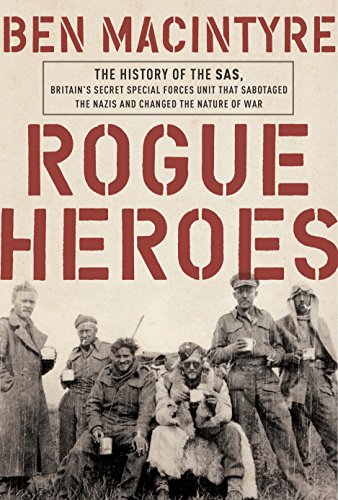Available at: Amazon US, United Kingdom, Canada, Germany, Australia
Apple, Nook, Kobo, GooglePlay and your Public Library!
This book is greatly flawed with factual inaccuracies that make me want to give some people a stern talking too. It is also entertaining and informative if one reads between the lines.
I first became aware of Rogue Heroes through the BBC docuseries of the same name. It tells the adventures of the Brit’s guerrilla fighting force, the SAS, in the Sahara during WWII. The descriptions of the desert and the characters was very entertaining. However, watching it I was struck by something: the character of “Paddy” Maine the “mad Irishman” seemed to be not of a person, but of a stereotype of an Irish person. (In the U.S. the Irish are very accepted. Not so all over the world.)
I got the book because I thought maybe the docuseries was just playing Patty’s “madness” up for dramatic purposes. Nope. It was pulled from the book. Little inconsistencies in the writing made me even more suspicious (Paddy was so “mad” except he was meticulously organized and a brilliant strategist and earned the devotion of all who served under him.) So I picked up Paddy Mayne: Lt Col Blair ‘Paddy’ Mayne, 1 SAS Regiment by Hamish Ross which uses more primary sources. (A dense book, but with amazing research.)
A lot of stories about Paddy in Rogue Heroes are made up whole cloth, and some of it is made up to cover the moral and organizational failings of David Sterling, the SAS’s “founder.” (There is some doubts even as to whether David Sterling founded the SAS. It seems it may really have been formed by his older brother, who worked for British Intelligence. David’s brother was smart, organized, capable, determined, hardworking and humble. David, his younger brother, was … brave but mostly a failure, and he talked. A lot.)
At one point in the docuseries, Paddy Maine shoots a bunch of Nazis in cold blood as they are relaxing in a pub beside an isolated airstrip. That … never happened. The planes on the airstrip were blown up, and then the outside of the pub had some explosives laid beside it to guard the retreat of the saboteurs as they made their escape. But the cold-blooded murder of unarmed men inside was made up by American newspapers.
Later, however, David Sterling, forever wanting to one-up Paddy who consistently showed himself to be the more strategic mind, did shoot men in cold-blood in the exact same scenario. After Paddy died not long after the war, David Sterling, down on his luck, played up Paddy’s imaginary exploit–perhaps to justify what he did.
The book is more accurate in its depiction of Paddy and Eowan (spelling?) relationship. The docuseries implies they were lovers. Eowan definitely wasn’t gay. Paddy may have been, no one knows. He was deeply hurt when Eowan died, but they’d been friends since long before the war. As teenagers, they played rugby together, and hung out at each others homes, and ate meals with each others families. Their mothers and siblings asked about the respective other in letters to the front. Losing a childhood friend like that would mess someone up.
Besides the treatment of Paddy, there were some other things I didn’t like about the book. Claiming that the SAS was the first guerrilla type force the British utilized, the first to use of saboteur tactics, and the first to bring those tactics to Churchills attention was the biggest. No. No. No. Churchill was way ahead of the SAS. (For a fantastic book on the subject, that I recommend without reservation, pick up Churchill’s Ministry of Ungentlemanly Warfare: The Mavericks who Plotted Hitler’s Defeat. It’s hilarious and profound. Unlike David Sterling, many of the “guerrilla” fighters who worked with the British, were motivated by humanitarian concerns, not just glory.)
However, the book is much more accurate than the docuseries in general, and it’s portrait of Jock Lewis is insightful and in-depth. The docuseries makes Jock seem uptight and virginal. Err … no. He had movie star good looks and had err, taken advantage of them. He’d been a big fan of Nazism, but had an about face while in Germany during Kristallnacht. He was a complicated man who recognized he’d been taken in by evil, and devoted his life to extinguishing that evil.
I believe most of the other characters and their relationships, particularly the friendship between upper-middle and working class Brits in the SAS were well done and really shine after Sterling gets captured.
Churchill’s Ministry of Ungentlemanly Warfare barely mentions the SAS in Africa, and this fills in a lot of the lore of the group. It’s entertaining, funny, and largely true. Anything attested to by David Sterling is probably dubious, so just read with that in mind.
So … a recommendation … with caveats.
